![]() Add To Cart This Word Template
Add To Cart This Word Template
 Add To Cart Proposal Pack Software #2
Add To Cart Proposal Pack Software #2
 Add To Cart Proposal Kit Professional Bundle
Add To Cart Proposal Kit Professional Bundle


Key Takeaways
- One-time License, No Subscriptions: Pay once and use Proposal Kit forever with an up-front price lower than monthly services over time.
- Best Template Flexibility: Start with a proven Electronic Records Management Sample Proposal and customize every section, logo, and color to fit your brand and project scope.
- Instant Access: Download immediately and open the sample proposal right away with no waiting, no onboarding delay.
- Ready-Made Structure: See a complete, real-world example (executive summary, scope, schedule, budget, and more) you can mirror for your project. Get a Proposal Pack or Professional package and use the AI Writer to create custom tailored samples or complete first drafts.
- Fully Editable Documents: Replace text, sections, and branding in minutes - no special software skills required.
- Step-by-Step Help: The Proposal Pack Wizard training mode, documentation, and videos guide you through customizing every section so you do not get stuck.
- Built-In Pricing and Quotes: Automate line-item quotes, totals, and taxes from a database, and insert tables/charts so your pricing is clear and consistent.
- Clear Pricing and Bundles: Choose a single industry pack or the Professional bundle for straightforward options that keep costs predictable as your needs grow.
How to write your Electronic Records Management Proposal
You can create your customized editable variation of this document using Proposal Kit. Follow these steps to get started.
 DOWNLOADABLE, ONE-TIME COST, NO SUBSCRIPTION FEES
DOWNLOADABLE, ONE-TIME COST, NO SUBSCRIPTION FEES
Proposal Pack includes everything you need to get started now
- This sample proposal plus
- Library of all 200 samples
- Library of editable templates
- All templates in this design
- Basic contracts and invoices
- Financial calculators
- Wizard proposal software
- How to Write a Proposal e-books
- Customize with your logo
Screenshots of 4 of 19 pages of this sample
Click the PDF View link above to see more. The complete sample is included in every Proposal Pack and the included Wizard software can build you an editable version in Word that will be in the design theme you purchased. You can purchase a different design theme than the sample is illustrated with.
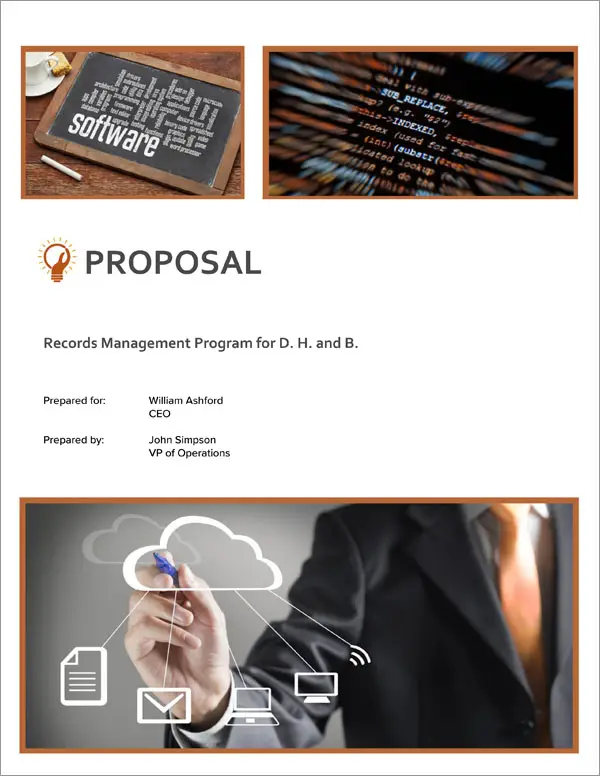
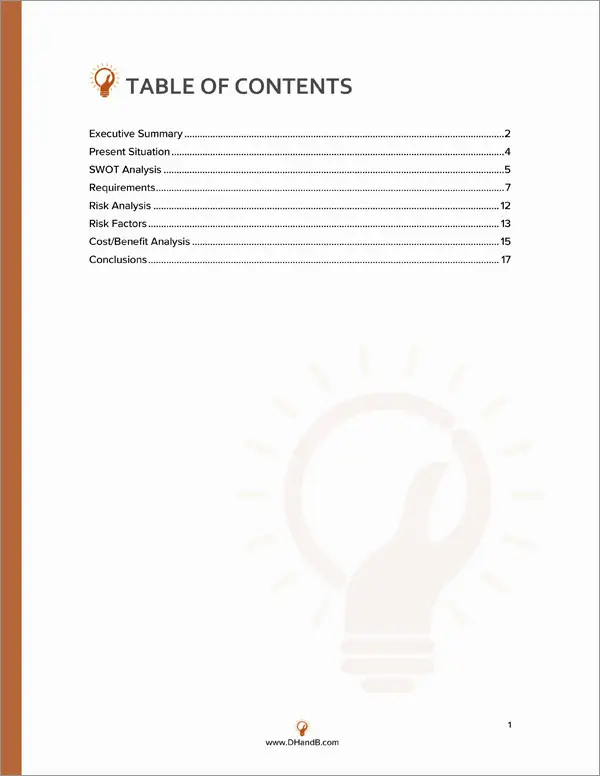
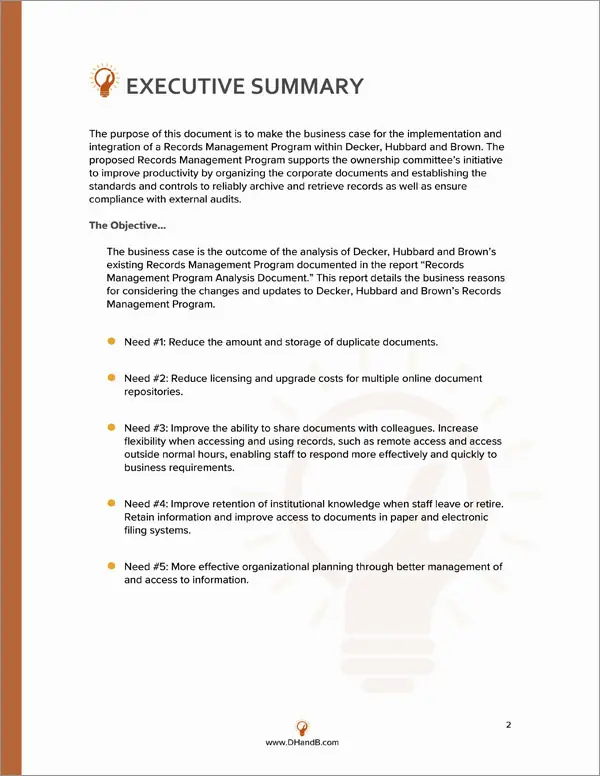
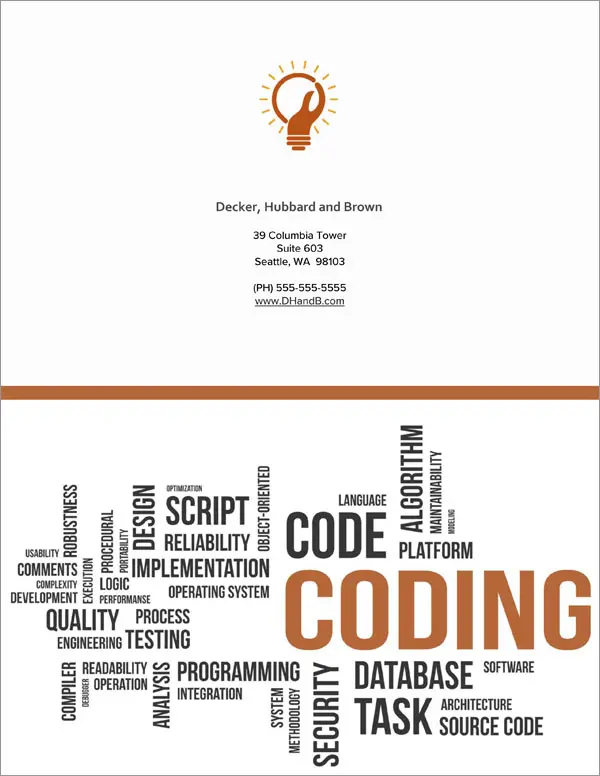
1. Get a Proposal Pack such as Software #2
This sample was created using the design theme Proposal Pack Software #2. You can recreate this same sample using any of our Proposal Pack design themes and have it customized for your business.
We include this sample in PDF and editable Word format chapters that can be customized using the included Wizard software when purchased with a Proposal Pack or the Professional Bundle.
To create your customized proposal using your logo and colors, get Proposal Pack for Any Business. We include this sample in every Proposal Pack.
2. Download and install after ordering
Once you have ordered and downloaded your Proposal Pack you will have all the content you need to get started. If you order the sample as a template you will download the Word document after ordering and edit it in your office software.
3. Set up the included Wizard software
While the Wizard software makes the process more efficient, you can manually assemble your version of this sample using the content provided and just a Word processor. We only include the Wizard software with a Proposal Pack or the Professional Bundle.
4. Import the Quick Start layout titled 'Electronic Records Management Sample Proposal'
The included Proposal Pack Wizard software makes creating a customized version of this document speedy and efficient. The sample content is in Word format documents, so you can also use the sample text without using our Wizard software. Using the Wizard software, you can create custom variations of this template and automate your quotes with the line item database.
This is a good example to follow for anyone proposing technical projects.
Anyone proposing technical projects.
5. Customize the template with your information
You can customize the layout with different chapters, change the order of chapters, import your content and information, change the visual design, edit the text, and more. You have complete control over customizing this sample. Use the Wizard's AI Writer to create personalized content specific to your business and project that can be merged with the sample.
Once finished, the AI Writer's Word-to-PowerPoint converter can transform your proposal, business plan, or other business documents into a PowerPoint slideshow.
Abstract
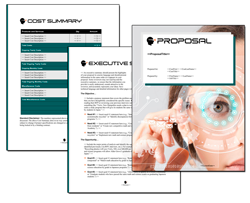
Electronic Records Management (ERM) represents an important advancement for organizations seeking to strengthen the governance, security, and accessibility of their information assets. An effective ERM program elevates a company as a leader in compliance and productivity by establishing standards and controls for archiving, retrieving, and protecting sensitive records. Implementing a records management system provides a central repository for both electronic and paper documents, reducing duplication, licensing costs, and storage challenges while streamlining collaboration and knowledge sharing across business units.
A robust ERM strategy addresses administrative, technical, and financial requirements, including the development of policies, classification schemes, and disaster preparedness plans. It supports regulatory compliance, audit readiness, and risk management by ensuring that records are managed throughout their lifecycle and that vital information is retained or disposed of according to corporate policy. The integration of advanced software solutions, such as enterprise content management (ECM) systems, further enables remote access, workflow automation, and secure access controls. Organizations that invest in ERM position themselves to respond more efficiently to stakeholder needs, maintain operational continuity, and support long-term growth. By using these capabilities, businesses set the foundation for effective organizational planning and sustained competitive advantage.
The need for comprehensive electronic records management has intensified as organizations handle increasing volumes of digital and legacy documents, often scattered across multiple repositories. Without a structured approach, companies face greater risks related to data loss, inefficient workflows, difficulty in responding to audits, and compliance failures. The implementation of an ERM program is not only about technology, but also about fostering a culture of information stewardship and aligning records management practices with goals.
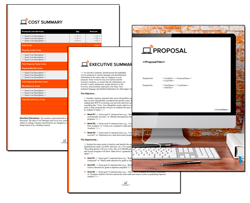
Using the Proposal Kit to create tailored records management proposals helps companies to clearly define project requirements, identify key stakeholders, and present a well-organized business case for change. The platform s automated document assembly, AI Writer, and extensive content libraries streamline the proposal process, allowing teams to focus on the substance - such as risk analysis, cost-benefit evaluations, and change management strategies - rather than formatting. As a result, organizations can present actionable, persuasive proposals that secure executive buy-in and facilitate smooth adoption of new systems.
For decision-makers, a robust ERM proposal highlights the return on investment from reducing operational costs, increasing staff productivity, and meeting regulatory demands. It enables organizations to proactively address challenges such as redundancy, poor communication, and a lack of formal policies. Moreover, with a centralized records management leader guiding the program, companies benefit from improved institutional knowledge transfer, rapid response to external audits, and enhanced client service. Ultimately, the adoption of a disciplined ERM approach positions organizations to thrive in a competitive and compliance-driven business environment.
A strong electronic records management initiative also plays a transformative role in organizational transparency and accountability. By enabling systematic classification and retention of records, ERM builds a foundation for informed decision-making, supports legal discovery, and protects intellectual property. Modern ERM programs are designed to be adaptable, accommodating regulatory requirements, remote work trends, and the growing need for data privacy. This adaptability is important for organizations striving to become leaders in their industry, particularly as data governance and digital transformation increasingly define business success.
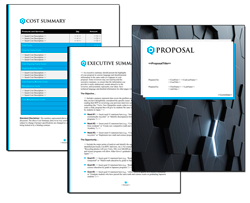
From a high-level perspective, the implementation of electronic records management solutions contributes to a company s resilience against disruptive events, such as cyber incidents or natural disasters, by ensuring that critical business information remains secure and accessible. Stakeholders - including clients, partners, and regulators - gain greater confidence in an organization s ability to manage risk and uphold commitments. Proposal Kit s guided process helps organizations articulate these benefits, anticipate and mitigate resistance to change, and map out milestones for continuous improvement.
A well-written ERM proposal addresses workforce development by incorporating training and change management, ensuring that employees are equipped to adopt new procedures and technologies. This fosters a culture where employees understand the value of accurate recordkeeping and are motivated to participate in ongoing improvements. By using tools that automate repetitive tasks and simplify compliance, organizations gain valuable resources for innovation and initiatives. In summary, effective records management not only secures compliance and efficiency but also elevates the organization s reputation, stakeholder trust, and capacity for long-term growth.
Electronic Records Management Sample Proposal - The Narrative
Records Management Program for D.H. and B.Decker, Hubbard and Brown
Decker, Hubbard and Brown is in need of a Records Management Program to organize our corporate documents. The following proposal supports the ownership committee’s initiative to improve productivity and establish standards and controls to reliably archive and retrieve records and ensure compliance with external audits. The purpose of this document is to make the business case for the implementation and integration of a Records Management Program within Decker, Hubbard and Brown.
The proposed Records Management Program supports the ownership committee’s initiative to improve productivity by organizing the corporate documents and establishing the standards and controls to reliably archive and retrieve records as well as ensure compliance with external audits.
The Objective
The business case is the outcome of the analysis of Decker, Hubbard and Brown’s existing Records Management Program documented in the report "Records Management Program Analysis Document." This report details the business reasons for considering the changes and updates to Decker, Hubbard and Brown’s Records Management Program. Reduce the amount and storage of duplicate documents. Reduce licensing and upgrade costs for multiple online document repositories.
Improve the ability to share documents with colleagues. Increase flexibility when accessing and using records, such as remote access and access outside normal hours, enabling staff to respond more effectively and quickly to business requirements. Improve retention of institutional knowledge when staff leave or retire.
Retain information and improve access to documents in paper and electronic filing systems. More effective organizational planning through better management of and access to information.
The Opportunity
The Records Management Program highlights the importance of effective records management and the opportunity for enhancements to the productivity of the business and stakeholders that can result from improved records management policies, procedures and systems. Develop a central records repository. Enable access to company records over the Internet.
Improve worker productivity. Improve audits and controls. Increase access and knowledge sharing. Reduce the storage of duplicate documents.
Protect sensitive information.
The Solution
This report has been developed to provide the assessment of the current records management state and the reasons for proceeding with the Records Management Program; including the options, requirements, cost, benefits, and management of updating and improving the existing Records Management Program. A program assessment was performed to gather enough information to enable management to determine whether or not to proceed with upgrading the existing Records Management Program and to identify technology that may help with Decker, Hubbard and Brown’s goals.
The Status of Decker, Hubbard and Brown’s Records Management Program
Decker, Hubbard and Brown’s corporate Records Management Program does not have a formal role within the organization. Storing the documents and identifying critical records is performed at a departmental or individual level and is combined with other roles and responsibilities. The long term management of documents is not seen as an important area of responsibility.
Decker, Hubbard and Brown has a records management policy covering file naming conventions, and there are multiple open and unsecured records repositories. Decker, Hubbard and Brown does not employ a trained records manager or someone with official responsibility for the management of the organization’s records, and there are no records management training initiatives.
The Current Environment of Records and Information
Decker, Hubbard and Brown’s electronic and paper information is stored and maintained in multiple electronic document management software EDMS , also known as Enterprise Content Management ECM software applications, and network file shares. Most of the company’s documents are generated electronically and stored electronically. Most paper documents received are scanned and placed in either a file share or EDMS, and then shredded or stored in a file cabinet.
There are no corporate policies and procedures in place for the evaluation and disposal of documents and no preparation is taken to ensure the long-term preservation and access to electronic information. Partial backups of the corporate information and documents are performed nightly and full backups are performed bi-weekly. Critical records required to keep the business operations functioning in the event of a disaster are not identified and governed by a policy or procedure to identify critical records and their management.
Decker, Hubbard and Brown will want to develop policies and procedures for the Records Management Program. The company will need to communicate to the organization how the policy is distributed to the staff, when to perform policy reviews, formalize the maintenance of records in all formats, and address how the records policy is implemented. A records survey of Decker, Hubbard and Brown’s documents is necessary to understand the exact nature and scope of records in the organization and to understand the effectiveness of storage and use and to be able to address the corporate mission and strategic objectives. A preliminary SWOT Strengths, Weaknesses, Opportunities, and Threats Analysis of Decker, Hubbard and Brown’s business highlights the following strengths and opportunities that can be further leveraged to provide insight for the motives to upgrade the Records Management Program.
The analysis also covers the consequences of not implementing a new approach to records management and helps identify how much risk is the organization may incur by doing nothing.
Strengths
- Successful consulting projects
- Excellent documentation for clients and projects
- Ability to make business and organizational changes quickly
- Strong customer base
- Established company over a decade in business
- Steady growth
Weaknesses
- Multiple content stores
- Lack of policies and procedures
- No formal change management process
- No formal training
- Poor communication
Opportunities
- High volumes of project and legacy documents exist.
- Highly developed project management methods and procedures exist.
- Infrastructure change can be rapidly deployed.
- Consolidating repositories and applying retention to records that can be destroyed will cut costs on storage and software licensing.
Threats
- IRS audits
- Third-party audits
- Document security
- Doing nothing
Allow users to easily review and research successful projects. Rapid deployment for the program. Cut cost and reduce storage. Open access to excellent documentation for clients and projects.
Rollout of the program is fast and changes are done quickly if desired. Better customer service for the strong customer base. Over a decade of legacy documents that will reduce cost by not recreating things.
Maintain steady growth through automation. Consolidate content stores. Open communication between business units will keep us from recreating the wheel. Rapid deployment of the program will reduce the potential fines from an IRS audit and speed up third-party audits of financial systems.
Increase document security. Develop a communication plan to promote the program and gain enthusiasm for the new system. Review and create policies to streamline current processes.
Increase information management and security. Develop policies and procedures that reduce duplicates. No formal change management process.
No formal training and change management. High volumes of project and legacy documents. Due to the organization of the business, change can be rapidly deployed.
Consolidating repositories and applying retention to records that can be destroyed will cut costs on storage and software licensing. The following project requirements will identify the administrative, technical, financial and other requirements to implement a Records Management Program or expand on an existing one.
Requirement #1 Administrative
Effective governance and company adoption of the Records Management Program needs to come from the senior management and individuals need to be identified along with the roles and tools of the program for it to be a success. Develop a company Records Policy and Procedure. Users must be trained on how to comply with the policies and procedures. Develop a classification scheme or file plan that organizes files and folders into logical groupings.
Define metadata that needs to be captured and used for searching documents. Identify or acquire personnel to manage the ongoing retention and disposal of records. Design a process for efficient and effective storage and retrieval of records. Develop security and access controls for all documents.
Establish a records management, information technology management and advisory committee to deliver governance of the records program. Devise a plan for vital records and disaster preparedness or emergency plan.
Requirement #2 Technical
Decker, Hubbard and Brown’s technical requirements address exact technical needs based on information gathered from the Program Analysis report. Strategy for Enterprise Content Management ECM Requirement. Decker, Hubbard and Brown has volumes of documents in multiple repositories that need to be centrally managed and migrated to a single source.
Consolidation of existing systems and documents on the network file share. Management of records and metadata for the purpose of central administration. The ability to be able to store, manage and render documents and records in their native file formats. Web-based ECM system for access anywhere.
Records Management Requirement
Decker, Hubbard and Brown needs the ability to manage all corporate documents according to organizational policies and to manage the complete document lifecycle to ensure regulatory compliance and reduce corporate risk. Support for a Decker, Hubbard and Brown organizational classification scheme and file plan. Ability to create classification schemes with a minimum of three levels of classification; Function, Transaction, and Activity.
Ability to make changes to the classification scheme. Changes tracked and logged in an audit trail. Ability to declare a record by a time or event trigger, such as a cutoff date.
Ability to perform a legal hold and freeze records and series by authorized users.
Capture Requirement
The central record system must be able to leverage technology to organize and manage Decker, Hubbard and Brown’s records. The solution will need to automate and streamline processes to minimize the need for extensive training and change management. Ability to capture bulk import records and metadata. Ability to import native files from the desktop.
Ability to scan paper documents. Ability to automatically import documents or records and propagate metadata for like series or groupings. Ability for knowledge works to contribute to the system and assign records categories at time of import.
Business Process Management Requirement. Decker, Hubbard and Brown needs to improve communication and collaboration of distributed documents like purchase orders, project documents and invoicing. The system must reduce the dependency of implied knowledge for business processes.
The central repository ECM system must have the ability to create a workflow using a standard GUI. The workflow engine must have standard out-of-the-box capabilities. Integrate with Standard Operating Systems Requirement.
Decker, Hubbard and Brown uses the Microsoft platform and the ECM system will need to work with older versions of SQL & Exchange. The system shall integrate into Microsoft SQL, Exchange, Office, Outlook, and Active Directory. The system must have out-of-the-box desktop application integration with Office, Outlook and the network file share.
Requirement #3 Financial
The proposed solution will be for Decker, Hubbard and Brown to migrate existing content to a centralized repository and improve on electronic records management. Funding should be set aside for a pilot program and additional resources budgeted for at least three years for the development and rollout of the enterprise solution. Decker, Hubbard and Brown will need to hire personnel, assign existing resources, and or acquire services and technology from external suppliers.
Implementing a Records Management Program requires involvement from internal and external resources. They have the overall responsibility for the success of the organization and are the ones setting its strategic goals and objectives. They should be included in all status reports. The duties of the legal department are to ensure that the organization is in compliance with legal and regulatory requirements and will be involved in the design of the ECM system.
A communication plan is critical and should start as early as possible. Acquiring a vendor or integrator will facilitate the need to go out for bids. Manager of the technology solution – usually an IT resource.
Desktop integrations, server maintenance, ECM deployment, general help desk. IT’s role is to ensure that the records repository is developed and implemented according to Decker, Hubbard and Brown’s technology and architectural requirements. Responsible for the operations of departmental functions, or other business units.
The Business Unit Manager’s staff will be required to participate to implement the Records Management Program. Managers need to understand the amount of involvement for staff so that the department can continue to run effectively. Typically individuals who understand the department’s records and may be used as champions and liaisons with the Records Manager.
The users are the ones who will be using the system and the ECM processes must be workable for the end users. They should be involved in the design and testing. The Records Manager develops the tools to manage the program such as records management policies and procedures, the file plan, and training material.
This may not be a full-time position. Decker, Hubbard and Brown will need to have a project manager to manage the project, schedule resources, and work with any third-party vendors. The selected vendor should be an expert in records management and be able to work with Decker, Hubbard and Brown to.
Develop a file plan. Develop classification schemes. Select and install software and hardware.
Perform migration of content from legacy applications. Assist on decisions for how far to go back with historical documents. Decker, Hubbard and Brown will appoint a project manager for the supervision of the selected suppliers and vendors to ensure all deliverables and milestones are met and on schedule. Analysis of potential risks is outlined below.
This list of risks is not necessarily a complete list of all possible risks. No guarantee is made that all possible risks have been determined, or if determined, that the analysis is completely accurate. The need for risk management and oversight of the operational impacts of the new Records Management Program should be studied and documented.
Enterprise ERM Risk Strategy
Supporting the development of a Records Management Program requires that Decker, Hubbard and Brown formally assess risk and prepare for potential issues and create strategies for addressing them before there are problems. High volumes of unorganized documents, disparate file naming conventions, and regulatory requirements are all high-risk components of the records program. A contingency plan is necessary in the event that the online access to documents fails and paper records are not easily accessible. Due to the minimal amount of records management policies and procedures in place and the need for more discovery and analysis of over a decade of information, the likelihood of project delays and a long project cycle is likely.
The table below list areas that will require detailed risk assessment.
Risk #1
Records policies are not accepted within Decker, Hubbard and Brown’s culture. Difficult users and negative feedback can be damaging to a new program. Change management, training, and communication plans will be a key component of the Records Management Program.
Risk #2
Key stakeholders or document silos may not be identified. Missed stakeholders can reduce the effectiveness of the Records Management Program by bypassing critical steps, documents, and users. Key stakeholders should have been identified during the vetting of the classification scheme.
Risk #3
Missed classified records and secured access. Inadvertent disclosure of secured records and loss of access. The access to electronic documents should be designed to replicate users' current access profiles.
Risk #4
Drop in Internet connectivity while searching for documents over the web. Reduced productivity and lack of confidence in the new program. The hardware and software should be specified to accommodate Decker, Hubbard and Brown’s peak periods. Records Management is a cost center and cost savings may be difficult to justify.
Increased productivity is often used to provide financial justification for developing or improving a Records Management Program. However, there are many expected benefits that are known and there is substantial evidence to show that Decker, Hubbard and Brown should receive a ROI in the following ways. Reduced licensing and operational cost of maintaining multiple repositories.
Developing records training programs to increase worker productivity. Records management is necessary to maintain a competitive edge. New policies will streamline current processes in increased productivity.
Increased information management and security. Improved staff performance through time saved searching for documents. More accurate retrieval of information leads to better business decisions.
Reduced staff costs for filing and managing paper records. Reduce the cost associated with maintaining records that have little to no value or are duplicates. Quicker ramp-up times for new hire on-boarding and acclimation to company knowledge. The proposed Records Program will reduce storage, reduce duplicate documents, and reduce licensing and upgrade costs for multiple online document repositories, while providing improved ability to share documents and enabling staff to respond more effectively and quickly to business requirements.
It is recommended that Decker, Hubbard and Brown. Proceed with the detailed records inventory and survey. Develop a File Plan and Classification structure for all content.
Consolidate and migrate documents into a single central repository. Develop Records Policies and Procedures. Develop a Governance Plan for the Records Management Program.
The design and development of a formal Records Management Program offers long term security and access to corporate knowledge. The program sets the foundation and governance for information management at an enterprise level and enables Decker, Hubbard and Brown to continue to operate efficiently, effectively, and competitively within the organizations industry.
 What Our Clients Say
What Our Clients SayI just started working with this product, and it is great. It has tons of great content."
IT Manager
Restech Information Services
There are 200 complete sample proposals including this one in each Proposal Pack
The following related samples are also included in Proposal Pack:
These template layouts are related to this sample
The following related templates are also included in Proposal Pack with this sample:
Length of Sample
19 PagesThere are thousands of chapters to choose from in Proposal Pack. This sample uses the following set of Proposal Pack chapter templates: Title Page, Table of Contents, Executive Summary, SWOT Analysis, Present Situation, Risk Analysis, Risk Factors, Requirements, Cost/Benefit Analysis, Conclusions, Back Page.
Electronic Records Management Sample Proposal Calculator Spreadheets
These Excel calculator spreadsheets are included with this template. If you purchase a Proposal Pack or the Professional Bundle, these proposal pages are generated using an automated line-item database in the included Wizard software. The calculator spreadsheets are intended for use when purchasing only the sample as a static Word template.
This sample illustrates how to write the following types of proposals
- General business proposal
- Technical proposal
- Project pitch proposal
- Internal company proposal
- IT, software, hardware proposal
- Records Management (RIM, ERM) material
- Many other types of proposals
Samples can be created in any Proposal Pack design theme
This sample was created with Proposal Pack Software #2. To change the visual look purchase any Proposal Pack and this sample will be created in that design theme.
Out of the over 501 Proposal Packs available these designs are also popular for this type of proposal and this sample proposal is also included in every Proposal Pack:
Photo Design Proposal Packs
 Proposal Pack Computers #5
Proposal Pack Computers #5 Proposal Pack Computers #6
Proposal Pack Computers #6 Proposal Pack Contemporary #19
Proposal Pack Contemporary #19 Proposal Pack Software #1
Proposal Pack Software #1Line Art Design Proposal Packs
 Proposal Pack Computers #1
Proposal Pack Computers #1 Proposal Pack Computers #4
Proposal Pack Computers #4 Proposal Pack Multimedia #1
Proposal Pack Multimedia #1 Proposal Pack Multimedia #2
Proposal Pack Multimedia #2 Proposal Pack Multimedia #3
Proposal Pack Multimedia #3 Proposal Pack Multimedia #4
Proposal Pack Multimedia #4 Proposal Pack Tech #4
Proposal Pack Tech #4 Proposal Pack Tech #6
Proposal Pack Tech #620% Off Discount
![]() Add To Cart This Word Template
Add To Cart This Word Template
 Add To Cart Proposal Pack Software #2
Add To Cart Proposal Pack Software #2
 Add To Cart Proposal Kit Professional Bundle
Add To Cart Proposal Kit Professional Bundle
 4.7 stars, based on 849 reviews
4.7 stars, based on 849 reviewsFrequently Asked Questions
How do I customize this sample to fit my specific project or business?
If you purchase this sample as a static template, it will be an editable Word format document; otherwise, if you buy a Proposal Pack or the Professional bundle, you can build a more customized editable Word document version of it using the included Wizard software. You can replace the sample information with your own, adjust the text to match your company's tone and style, and modify sections to include project-specific details. The included AI Writer will also customize the content for you.
Can I use multiple sample proposals for different types of projects?
You can purchase multiple samples as individual Word templates or all 200 samples are included in every Proposal Pack and Proposal Kit Professional, which is a much better deal. The Proposal Kit offers sample proposals for various industries and project types. You can select and customize different sample proposals to suit each unique project. This flexibility allows you to create tailored proposals for other clients or projects.
How can I integrate my branding into this sample?
While this sample is an editable Word document, depending on the level of custom branding needed, consider the Proposal Kit Professional, which includes the branding features in the Wizard software that let you create custom-branded design themes more effectively. Start by incorporating your company's logo on the cover page, as well as in the headers and footers of the document. Next, adjust the color scheme of the proposal to match your brand colors. Change the fonts in the proposal to align with your brand's standard fonts. Including branded graphics that reflect your brand's style will further enhance the proposal. Additionally, ensure that the text within the proposal maintains a tone and voice consistent with your brand's communication style. By integrating these elements, your proposal will reinforce your brand identity.
How do I ensure my proposal stands out and wins the client?
To ensure your proposal stands out:
- Personalize the content: Address the client's needs, challenges, and goals to make the proposal unique.
- Highlight your value proposition: Communicate what sets your business apart and how to deliver superior results.
- Use professional design elements: Incorporate visuals, charts, and graphs to enhance the presentation and make it more engaging.
- Proofread and edit: Ensure the proposal is error-free and well-organized. A polished, professional document reflects your attention to detail and professionalism.
What should I do if I need help understanding or modifying a section of this sample?
If you need help understanding or modifying a section of this sample, refer to the detailed instructions provided. Additionally, Proposal Kit includes customer support and resources such as tutorials and videos to assist you. Consulting with a colleague or a professional in your industry can also be beneficial if further clarification is needed. Asking an AI tool can also provide valuable insights for immediate needs. You can load this sample into the Wizard software and let its AI Writer customize the pages for you.
 Ian Lauder has been helping businesses write their proposals and contracts for two decades. Ian is the owner and founder of Proposal Kit, one of the original sources of business proposal and contract software products started in 1997.
Ian Lauder has been helping businesses write their proposals and contracts for two decades. Ian is the owner and founder of Proposal Kit, one of the original sources of business proposal and contract software products started in 1997.By Ian Lauder
 Published by Proposal Kit, Inc.
Published by Proposal Kit, Inc.


 Cart
Cart
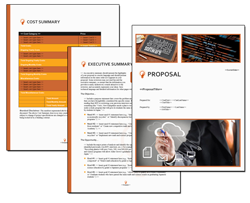

 Facebook
Facebook YouTube
YouTube Bluesky
Bluesky Search Site
Search Site